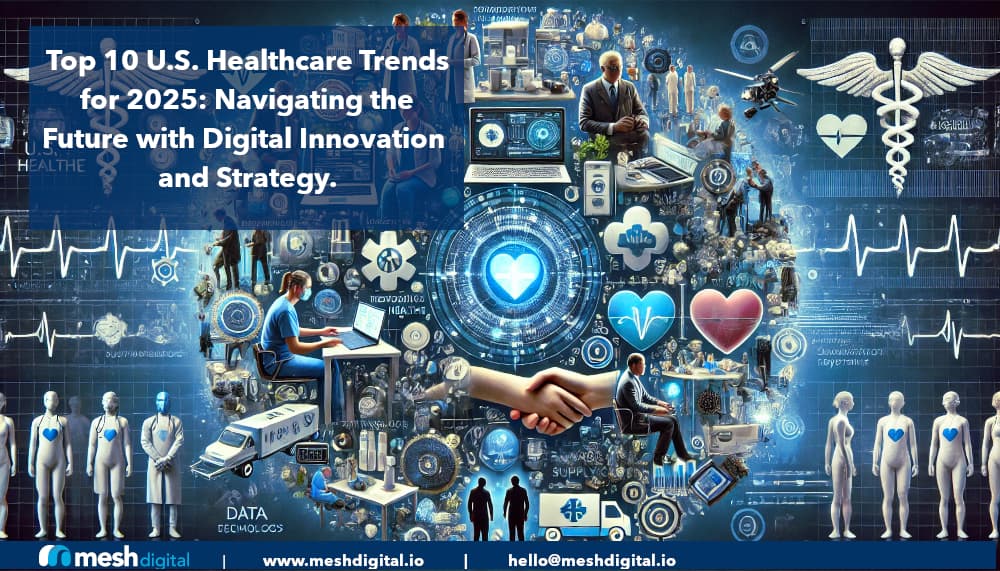Top 10 U.S. Healthcare Trends for 2025: Navigating the Future with Digital Innovation and Strategy
In this article the team at Mesh Digital LLC explores its Top 10 Trends upcoming in U.S. Healthcare for 2025, highlighting the impact of technological advancements and shifting patient expectations.

The U.S. healthcare industry is on the cusp of transformative change (if begrudgingly so) as we approach 2025. Technological advancements, shifting patient expectations, and evolving business models are driving these changes, creating a landscape that demands adaptability, innovation, and strategic foresight. Below are the top 10 trends that will shape U.S. healthcare in the coming year.
Abstract (TL;DR)
In this article the team at Mesh Digital LLC explores its Top 10 Trends upcoming in U.S. Healthcare for 2025, highlighting the impact of technological advancements and shifting patient expectations. Key trends include increasingly engaged patients using continuous health monitoring, the rise of digital clinician empowerment through AI and personalized medicine, and the adoption of new working models with automation and task-shifting. The article also discusses the central role of MedTech in driving healthcare innovation, the emergence of digitally enabled supply chains, and the growing importance of trusted partnerships to accelerate innovation. Additionally, data is becoming a new currency in healthcare, with AI-powered tools like medical chatbots and cloud computing laying the foundation for a self-sufficient health ecosystem. These trends represent a shift towards more personalized, efficient, and accessible healthcare, offering providers a roadmap to navigate the challenges and opportunities of the future.
1. Increasingly Engaged Patients: The Era of Health Ownership
Patients are more engaged in their health than ever before (again begrudgingly). With a growing awareness of the impact of lifestyle choices on overall well-being, individuals are taking proactive steps to manage their health. This trend is supported by advancements in geriatric science, regenerative medicine, and precision medicine, which offer new insights into healthy aging. These "AgeTech" solutions are empowering older adults to live safely and independently for longer periods, while continuous health monitoring technologies allow individuals to track their health in real-time, reducing the need for intermittent check-ups (Accenture, 2023). Additionally, mental health monitoring has become more sophisticated, utilizing face recognition technology, sleep pattern analysis, and mood tracking to identify changes in mental well-being. Personal health information is now easily accessible and securely managed, giving individuals control over who can access their health records and why.
2. Digital Clinician Empowerment: The Tech-Driven Paradigm Shift
Medicine is undergoing a paradigm shift, where diagnoses and treatment decisions are increasingly based on predictive, preventive, personalized, and participatory (P4) medicine. This shift is driven by breakthroughs in AI, nanotechnology, cloud computing, and 5G, which enable faster and more customized diagnostic pathways. Clinicians are now supported by AI-enabled decision tools that deliver hyper-personalized, evidence-based prevention and treatment interventions. Point-of-care diagnostics and deep knowledge of diseases allow clinicians to determine the treatments most likely to benefit their patients, enhancing the precision and effectiveness of care (Deloitte, 2024).
3. New Ways of Working: Building a Sustainable Workforce
The future of healthcare is as much about people than it is about technology. Automation, robotics, and digitally enabled insights are helping healthcare providers with task-shifting and role enrichment, creating a more sustainable and adaptable workforce. Healthcare professionals (HCPs) are being trained to develop cognitive, digital, emotional, and analytical skills, enabling them to communicate effectively with each other and with patients. This training also provides HCPs with the confidence to discuss AI-enabled diagnostics and genomics testing results with their patients. Provider infrastructure is evolving to support data sharing across organizational boundaries, while pharmacists are continually taking on more caregiver roles (especially via retail pharmacies), offering online consultations and remotely monitoring medication adherence (PwC, 2024).
4. Patient Experience Centricity Drives Outcomes
In 2025, healthcare delivery models will be increasingly patient-centric, with a digital-first approach that directs patients to the most appropriate care settings. Networks of primary care providers will manage population health needs within this patient-centric model. AI-enabled remote patient monitoring (RPM) and point-of-care diagnostics will collect and interpret real-time data on vital signs, allowing for more coordinated, efficient, and cost-effective care. Enhanced communication between HCPs will further improve care coordination, leading to better health outcomes and increased patient satisfaction (McKinsey & Company, 2023).
5. MedTech Drives the Future of Health
MedTech is at the forefront of healthcare innovation, focusing on transformative technologies that enhance products and services while enabling P4 medicine. These companies are leveraging sophisticated data analytics and partnering with consumer-focused tech companies to benefit from their experience in brand development, customer engagement, and advanced analytics. MedTech companies are also becoming “Software as a Service” (SaaS) providers, targeting preventive care at specific patient groups. Companion diagnostics, a crucial tool for personalizing patient therapy, are increasingly driven by MedTech innovations. These advancements are enabling a systems approach to biology and medicine, providing personalized information about an individual’s unique health experience at the molecular, cellular, and organ levels. This approach is making disease care more cost-effective by treating the root causes rather than the symptoms of disease (Deloitte, 2024).
6. Digitally Enabled Supply Chains: The Backbone of Healthcare
In 2025, healthcare supply chains will be more interconnected and digitally enabled than ever before. Companies are using interoperable data to improve end-to-end visibility across the supply chain. Blockchain technology is making track-and-trace capabilities a reality, from manufacturing to patient delivery. AI technologies are transforming supply chain and manufacturing processes through real-time data processing and decision-making, reducing the risks of human subjectivity and bias. Advanced analytics are unlocking insights from commercial, regulatory, and operational data, improving demand forecasting, inventory management, logistics optimization, procurement, and workforce planning (Gartner, 2024).
7. Trusted Partnerships Accelerate Innovation
Trusted partnerships between industry (e.g., Mesh Digital LLC), academia, and healthcare providers are becoming a central feature of successful health clusters. These partnerships, backed by creative financial services sectors and government initiatives, create optimal conditions for developing new business models and delivering savings across the healthcare ecosystem. Health clusters accelerate digital transformation by establishing new standards for data sharing, analysis, and transparency. These standards improve trust, drive efficiencies, expand access, and reduce costs, making healthcare more accessible and affordable (Accenture, 2023).
8. Data as a New Healthcare Currency
The development of precision medicine and better predictions of patient behavior are increasingly driven by generative AI (GenAI) and real-world evidence. Large language models (LLMs) are becoming capable of determining differential diagnoses, informing clinicians, and assisting in setting treatment regimens, significantly reducing the likelihood of human errors. As data becomes a new currency in healthcare, it will play a crucial role in personalizing care and improving patient outcomes (PwC, 2024).
9. Medical Chatbots: The Next Frontier in Healthcare Automation
Medical chatbots, powered by AI, are becoming indispensable tools in healthcare. These digital assistants automate various healthcare processes, such as collecting and encrypting patient data, assisting with prescription refills, providing informational support, scheduling appointments, and ensuring medical assistance. The functionality and cost-effectiveness of medical chatbots are driving their rapid adoption across the healthcare industry, making them a must-have tool for providers looking to enhance patient engagement and streamline operations (Gartner, 2024).
10. Cloud Computing: The Foundation of a Self-Sufficient Health Ecosystem
Migrating data to the cloud is among the leading trends in healthcare, offering significant benefits in data management optimization and cost reduction. Cloud computing enables healthcare organizations to draw intelligent insights from data, mitigate risks, and improve decision-making accuracy. The technology also provides greater flexibility in responding to industry needs, enhances the transparency of health information, and supports the development of smart healthcare communities and digital supply chains. As cloud-based systems enable better communication and collaboration across the healthcare ecosystem, they will play a pivotal role in establishing a self-sufficient health ecosystem (IBM, 2023).
Conclusion
The U.S. healthcare industry in 2025 will be defined by innovation, technology, and a patient-centric approach. From increasingly engaged patients to digitally enabled supply chains, these trends represent a shift toward more personalized, efficient, and accessible healthcare. By embracing these trends, healthcare providers can navigate the challenges of the future and deliver better outcomes for patients.
References
Accenture. (2023). Health trends for 2025: The rise of patient engagement. Retrieved from https://www.accenture.com/us-en/insights/health/2025-trends
Deloitte. (2024). MedTech and the future of health: Transforming care with technology. Retrieved from https://www2.deloitte.com/us/en/pages/life-sciences-and-health-care/articles/medtech-future-health.html
Gartner. (2024). The impact of digital supply chains on healthcare. Retrieved from https://www.gartner.com/en/documents/impact-digital-supply-chains-healthcare
IBM. (2023). Cloud computing in healthcare: Building a self-sufficient ecosystem. Retrieved from https://www.ibm.com/cloud/insights/cloud-computing-healthcare
McKinsey & Company. (2023). Patient experience centricity in healthcare: The key to better outcomes. Retrieved from https://www.mckinsey.com/industries/healthcare/our-insights
PwC. (2024). The future of healthcare: Data as a new currency. Retrieved from https://www.pwc.com/us/en/industries/healthcare/future-of-healthcare.html
